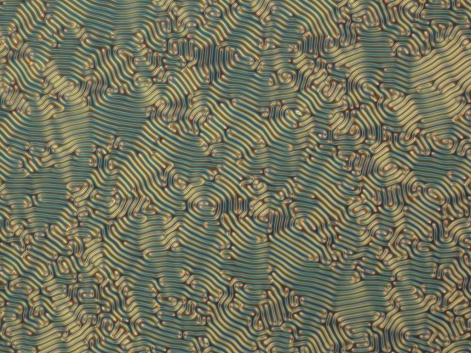Scientists told about the benefits of cholesteric liquid crystals
29 October 2019 г.

The most famous applications of liquid crystals are displays for modern televisions and smartphones, and glass, which are color and transparency self-adjusting, depending on the brightness of the sun's rays penetrating the room. The key difference between cholesteric and ordinary liquid crystals (nematics) is their structure - a complex twisted spiral resembling the DNA structure.
“To study cholesterics is very important, because they are much more complicated and interesting than the usual liquid crystals used in the production of displays in modern televisions and smartphones. For example, the length of the reflected light wave depends on the helix pitch - a drop of cholesteric can instantly change its color, resembling the chameleon’s skin. Most of the methods of using this material are based on this property, "says a senior research associate at the L.V. Kirensky Institute of Physics SB RAS, associate professor at Siberian Federal University Mikhail Krakhalev.
According to the scientist, cholesteric liquid crystals can be used in the production of electronic paper. Unlike flat-panel liquid crystal displays, the image on such paper is reproduced in reflected light and can store text and graphics for a quite long time. This will help save forests and electricity. In addition, cholesteric crystals can be used as sensors, as they are sensitive to biological antibodies and various impurities in water. The cholesteric sensors can instantly indicate that the water is unfit for consumption.
A beneficial bonus for the application of cholesterics is the possibility of their repeated use: you just need to remove the “chameleon drops” from the test liquid and they are ready to be used again. A more difficult option for using this material is tunable lasers, which are in demand in medicine. Cholesteric crystals will allow us to create a device which will replace three conventional ones.
As part of the experiment, for the first time in the world the researchers from the Institute of Physics SB RAS and Siberian Federal University systematized the structure of the drops, in which the molecules of the liquid crystals at the boundary of a drop were oriented perpendicular to the surface.
"A detailed study of the behavior of cholesterics will contribute to the development of materials and technologies which will significantly reduce the burden on the environment. In general, the creation of systems which could quickly adapt to external changes by rebuilding their own structure is important not only for fundamental science. This would be a tremendous practical background for the future, serving as a transition to the world of new nature-like "adaptable" materials, " concludes the co-author of the study, associate professor of the department of instrument engineering and nanoelectronics of SibFU, Anna Gardymova.
Source: RIA Novosti
Share:
